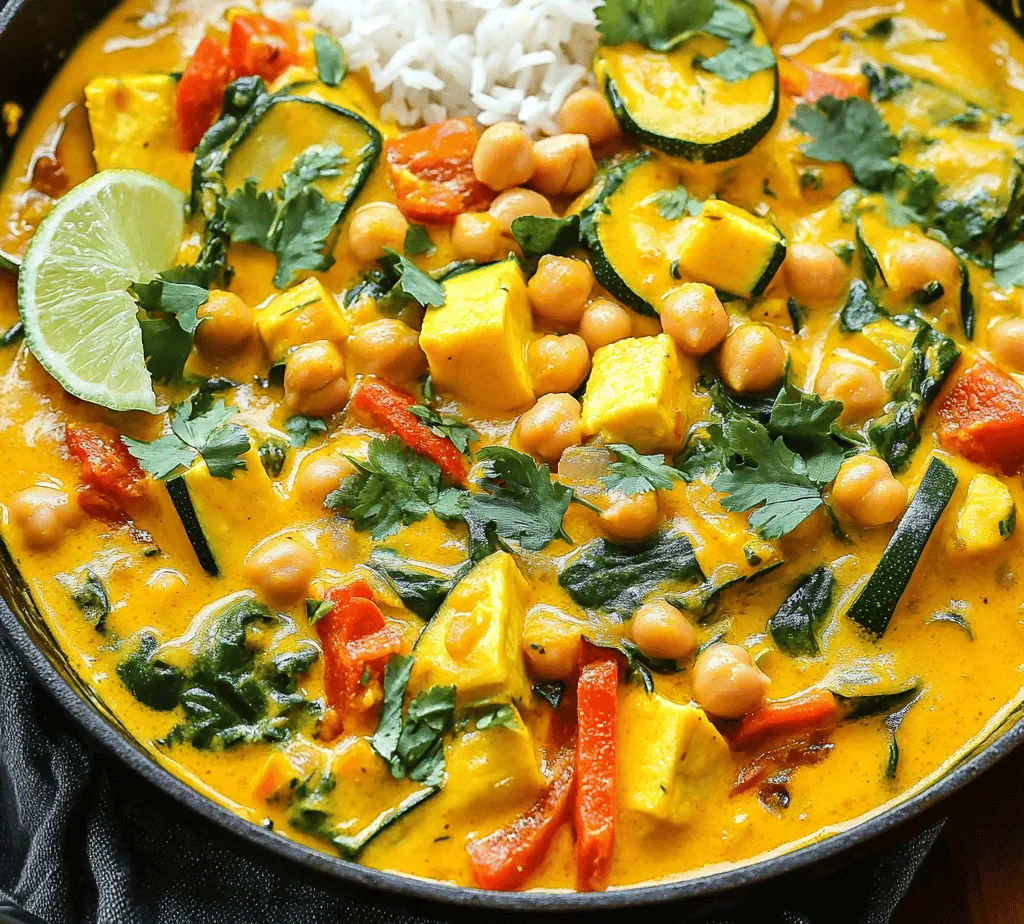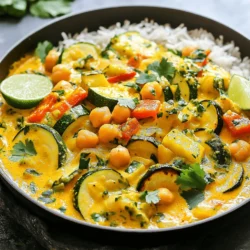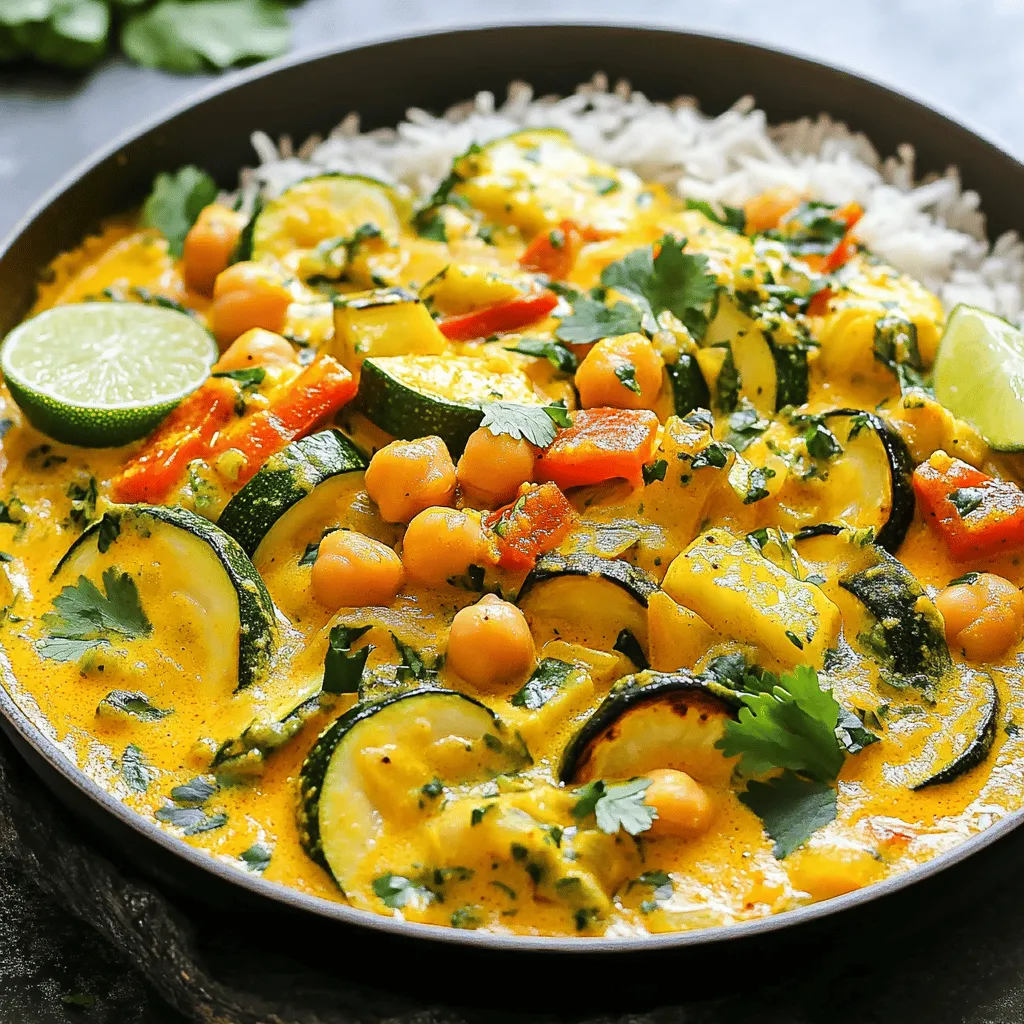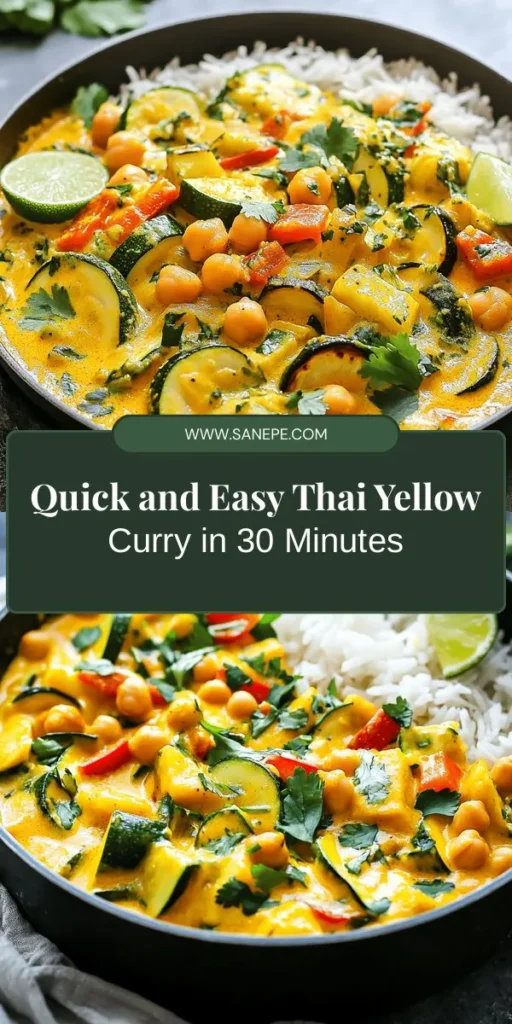Introduction
Thai cuisine is celebrated worldwide for its vibrant flavors, aromatic spices, and colorful dishes that tantalize the taste buds. This culinary tradition harmoniously combines sweet, sour, salty, and spicy elements to create a unique dining experience. With an increasing number of people leading busy lives, the demand for quick and easy recipes has surged. Enter the Easy 30-Minute Thai Yellow Curry—a dish that encapsulates the essence of Thai cooking while fitting seamlessly into a hectic schedule.
This delightful curry not only satisfies your taste buds but also brings a wealth of health benefits to the table. Packed with nutrient-rich vegetables, plant-based protein, and the goodness of coconut milk, this recipe caters to various dietary needs, making it ideal for vegetarians, vegans, and those looking to incorporate more wholesome foods into their meals. In just half an hour, you can whip up a comforting bowl of curry that reflects the vibrant spirit of Thailand, all while ensuring that you and your loved ones enjoy a nourishing meal.
Understanding Thai Yellow Curry
Thai yellow curry, known as “Kaeng Kari” in Thai, is one of the milder curry varieties in Thai cuisine. Its origins trace back to the southern regions of Thailand, where the influence of Indian cuisine is prevalent. The use of turmeric in the curry paste gives it a distinctive yellow hue and contributes to its earthy flavor profile. Unlike its spicier counterparts, the green and red curries, yellow curry strikes a balance that appeals to a wider audience, making it an excellent choice for those who may be sensitive to heat but still crave the aromatic depth of Thai food.
At the heart of Thai yellow curry are its key ingredients, which include turmeric, coriander, cumin, and lemongrass. These components not only provide flavor but also offer numerous health benefits. Turmeric, for instance, is known for its anti-inflammatory properties, while coconut milk adds creaminess along with heart-healthy fats. The choice of vegetables and protein, such as chickpeas, enhances the nutritional profile, ensuring each serving is both satisfying and nourishing.
To fully appreciate yellow curry, it helps to compare it with other popular Thai curries. While green curry is packed with the punch of fresh green herbs, and red curry is known for its richer and more robust flavor thanks to red chili peppers, yellow curry is characterized by its warmth and subtle sweetness. This makes it a versatile option that can be enjoyed by those who might find other curries too intense.
Ingredients Breakdown
Creating a delicious Thai yellow curry requires a thoughtful selection of ingredients. Below, we delve into each component that makes this dish special, discussing their health benefits and cooking properties.
Coconut Oil
Coconut oil is the foundation of many Thai dishes, and for good reason. Its high smoke point makes it perfect for sautéing, and its subtle coconut flavor enhances the overall taste of the curry. Coconut oil is also celebrated for its medium-chain triglycerides, which may support heart health and provide a quick source of energy.
Aromatic Trio: Onions, Garlic, and Ginger
The trifecta of onions, garlic, and ginger forms the aromatic backbone of the curry. Onions provide sweetness and depth, while garlic adds a pungent kick that elevates the flavor. Ginger, with its warm, peppery notes, brings a refreshing zest that complements the spices in the curry. Together, they create a fragrant base that is essential for any successful curry.
Thai Yellow Curry Paste
The star of the show is undoubtedly the Thai yellow curry paste. Typically made from a blend of spices, herbs, and aromatics, this paste is what gives the curry its distinctive flavor profile. When selecting curry paste, look for brands that use high-quality ingredients without added preservatives. You can also make your own at home, allowing for customization based on personal taste preferences. Store any leftovers in an airtight container in the refrigerator for up to a week or freeze for longer storage.
Coconut Milk
Coconut milk contributes a luxurious creaminess to the curry while providing a rich source of healthy fats. It is also a wonderful dairy alternative for those with lactose intolerance or following a vegan diet. Nutritionally, coconut milk is packed with vitamins and minerals, including potassium and magnesium. If you are looking for lower-calorie options, consider using light coconut milk or blending regular coconut milk with vegetable broth.
Vegetable Broth
The choice of broth can significantly impact the final taste of the curry. Vegetable broth adds depth and flavor without overpowering the other ingredients. You can use store-bought broth, but making your own at home allows for greater control over the flavor profile. Homemade vegetable broth can be made by simmering vegetable scraps, herbs, and spices in water, yielding a richer and more nuanced flavor.
Fresh Vegetables: Zucchini, Red Bell Pepper, and Baby Spinach
Incorporating fresh vegetables not only enhances the taste but also boosts the nutritional value of the curry. Zucchini adds a mild sweetness and a satisfying crunch, while red bell peppers contribute vibrant color and a dose of vitamin C. Baby spinach, when added towards the end of cooking, wilts quickly and provides iron and other essential nutrients. Feel free to substitute or add vegetables based on seasonal availability or personal preferences.
Chickpeas
Chickpeas are a fantastic source of plant-based protein, making them a perfect addition to this curry. They are rich in fiber, which promotes digestive health and helps keep you feeling full longer. Moreover, chickpeas contain essential vitamins and minerals, including iron and magnesium, making them an excellent choice for vegetarian and vegan diets.
Soy Sauce vs. Tamari
When it comes to seasoning the curry, both soy sauce and tamari can be used to add depth and umami flavor. Soy sauce is made from fermented soybeans and wheat, while tamari is a gluten-free alternative made primarily from soybeans. If you are looking for a gluten-free option, tamari is the way to go, ensuring that everyone can enjoy this delightful dish.
Garnishes: Cilantro and Lime
Finishing touches like garnishes can elevate the presentation and flavor of your dish. Fresh cilantro adds a burst of freshness and complements the rich flavors of the curry. Lime, on the other hand, brings a zesty brightness that cuts through the creaminess of the coconut milk. A squeeze of lime just before serving can transform the dish, offering a refreshing contrast that balances the richness of the curry.
Preparation Steps in Detail
Now that we understand the ingredients that make up our Easy 30-Minute Thai Yellow Curry, let’s walk through the preparation steps that will lead you to a delicious meal.
Step 1: Heat the Oil and Sauté Aromatics
Start by heating coconut oil in a large skillet or saucepan over medium heat. Allow the oil to become hot but not smoking. Once heated, add chopped onions and sauté until they become translucent and fragrant. This step is crucial as it builds the flavor base for your curry. After the onions have softened, add minced garlic and grated ginger, stirring until they release their aromatic fragrances. This combination forms the heart of the curry, setting the stage for the vibrant flavors to come.
Step 2: Build the Flavor Base with Curry Paste
Next, it’s time to introduce the Thai yellow curry paste. Add a generous spoonful to the pot and stir it into the sautéed aromatics. Allow the paste to cook for a minute or two, as this helps to release its essential oils and flavors, intensifying the overall taste of the curry. You may need to adjust the quantity of curry paste based on your personal heat tolerance and desired flavor intensity.
Step 3: Achieve the Right Consistency with Coconut Milk and Broth
Once the curry paste is well incorporated, pour in the coconut milk and vegetable broth. Stir the mixture thoroughly, ensuring that the curry paste dissolves completely into the liquid. The goal here is to achieve a smooth and creamy consistency. Depending on your preference for thickness, you can adjust the amount of broth or coconut milk used. If you prefer a thinner curry, add more broth; for a richer texture, reduce the broth slightly.
Step 4: Timing for Adding Vegetables
As the curry simmers, it’s essential to add the vegetables at the right time to maintain their texture and nutrients. Start with the zucchini and red bell pepper, allowing them to cook for a few minutes until they begin to soften. Finally, add the baby spinach, stirring just until it wilts. This timing ensures that each vegetable retains its vibrant color and crunch, adding both visual appeal and nutritional benefits to your dish.
By following these initial steps, you are well on your way to creating a comforting and delicious Easy 30-Minute Thai Yellow Curry that will delight your palate and nourish your body. As we continue to explore this recipe, we will delve into final adjustments, serving suggestions, and additional tips to elevate your culinary creation even further.

Final Touches: Balancing Flavors
As you near the end of your Easy 30-Minute Thai Yellow Curry, it’s crucial to achieve the perfect balance of flavors to elevate your dish. After allowing the curry to simmer and meld together, taste your creation. You might find that it needs a touch more salt, a dash of soy sauce, or a sprinkle of black pepper to bring out all its vibrant notes fully.
Soy Sauce: Adding a splash of soy sauce not only boosts umami but also complements the sweetness of the coconut milk and the heat from the curry paste. Start with a teaspoon, stir, and adjust according to your taste preferences.
Salt and Pepper: If you opt for low-sodium soy sauce, you may need to add a little more salt to achieve the desired flavor. Always add salt gradually; it’s easier to add than to fix an overly salty dish. A pinch of freshly cracked black pepper can also enhance the depth of flavor, giving your curry a subtle kick.
Serving Suggestions
Once your curry is perfected, it’s time to dish it up. Serving your Thai Yellow Curry can turn a simple meal into a delightful experience.
Ideal Pairings: The classic pairing for Thai curry is jasmine rice, known for its delicate floral aroma and slightly sticky texture, which beautifully complements the richness of the curry. Alternatively, quinoa is a fantastic option for a protein-packed side. Quinoa is gluten-free, high in fiber, and loaded with essential amino acids, making it a nutritious choice that balances the creaminess of the curry. When choosing between these two, consider your dietary goals and preferences.
Presentation Tips: The visual appeal of your dish plays a significant role in the dining experience. Serve your curry in a deep bowl to showcase the colors of the vegetables and the golden hue of the sauce. Garnish with freshly chopped cilantro or Thai basil for a pop of green. A wedge of lime on the side not only adds a splash of color but also a refreshing zest when squeezed over the top before enjoying.
Additional Toppings or Sides: For an added crunch and flavor, consider topping your curry with roasted peanuts or cashews. A sprinkle of sesame seeds can also enhance the dish’s presentation and texture. If you want to serve a side, consider a light cucumber salad dressed in vinegar and sugar to provide a refreshing contrast to the rich curry.
Health Benefits of Thai Yellow Curry
Thai Yellow Curry isn’t just delicious; it also packs a nutritious punch thanks to its wholesome ingredients.
Nutritional Benefits: The primary ingredients—vegetables, coconut milk, and spices—offer various health benefits. Vegetables like bell peppers and carrots are rich in vitamins A and C, while potatoes provide fiber and potassium. Coconut milk, used as the base, is high in medium-chain triglycerides (MCTs) which can support heart health and may help with weight management.
Anti-inflammatory Properties: The spices found in curry, such as turmeric, ginger, and garlic, are known for their anti-inflammatory properties. Turmeric, in particular, contains curcumin, a powerful anti-inflammatory and antioxidant compound that may aid in reducing the risk of chronic diseases.
Coconut Milk’s Role: Coconut milk is a staple in many Thai dishes and provides a creamy texture without dairy. It contains healthy fats that can help maintain energy levels and support a balanced diet when consumed in moderation.
Vegetarian and Vegan Aspects: This recipe is naturally vegetarian and can easily be adapted to be vegan by using plant-based protein sources. The incorporation of vegetables ensures a variety of nutrients, making it an excellent choice for those looking to embrace plant-based eating.
Cultural Significance of Thai Curry
Thai Yellow Curry is more than just a meal; it’s a reflection of Thailand’s rich culinary heritage.
Enjoyment in Thailand: In Thailand, curries are often enjoyed as a communal dish, served alongside rice and shared among family and friends. This tradition highlights


